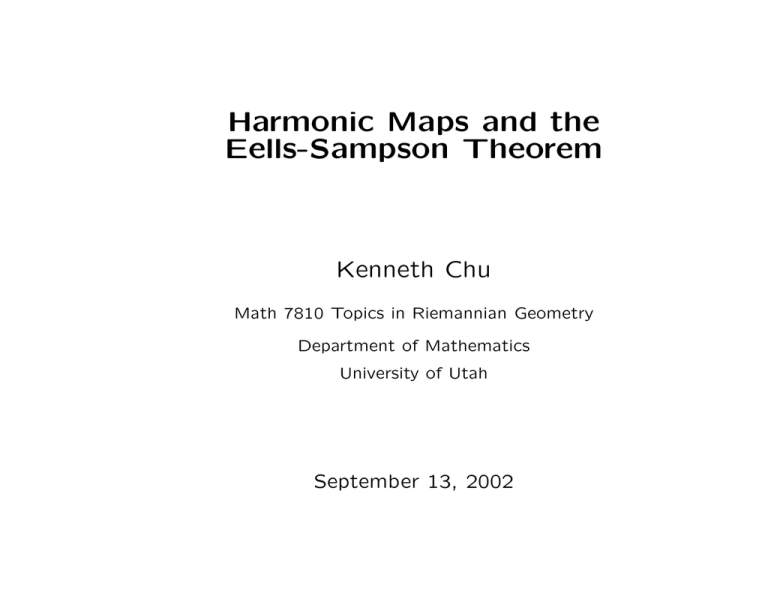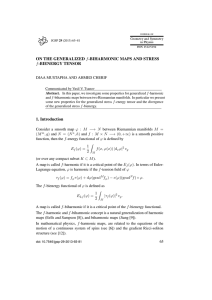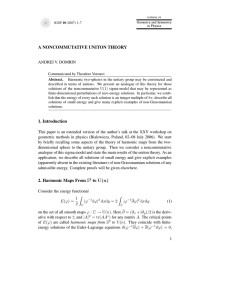Harmonic Maps and the Eells-Sampson Theorem Kenneth Chu September 13, 2002
advertisement

Harmonic Maps and the
Eells-Sampson Theorem
Kenneth Chu
Math 7810 Topics in Riemannian Geometry
Department of Mathematics
University of Utah
September 13, 2002
Abstract
The definition and examples of harmonic maps between
Riemannian manifolds will be given. The Eells-Sampson
Theorem will be stated and its proof outlined.
The Eells-Sampson states that any smooth map from a
compact Riemannian manifold into a compact
Riemannian manifold with non-positive sectional
curvature is homotopic to a harmonic map.
What Is a Harmonic Map?
Recall geodesics: Let γ : [a, b] −→ M be a smooth curve
in a Riemannian manifold M .
The arclength of γ is defined to be:
L(γ) :=
Z b
a
|γ̇(t)| dt.
The energy of γ is defined to be:
1 b
E(γ) :=
|γ̇(t)|2 dt.
2 a
Z
Fact: Minimizing the energy with respect to fixed
endpoints yields a curve which is locally
arclength-minimizing and parametrized by arclength.
A Necessary Condition for a Minimizer:
The Euler Equation
Let γ := [0, 1] −→ M be a smooth curve. Let F : [0, 1] × (−, ) −→ M
be a smooth map such that γ(t) = F (t, 0), F (0, s) = γ(0) and
F (1, s) = γ(1). Such an {F (·, s)}s is called a smooth variation of γ
with fixed end points.
Then, computations show:
Z 1 d
∂F E(F
(·,
s))
=
−
, ∇γ̇ γ̇ dt
ds s=0
∂s s=0
0
d If γ is to minimize energy, we must have
E(F (·, s)) = 0, for
ds s=0
any such smooth variation F (·, s) of γ. Hence
∇γ̇ γ̇ = 0
is a necessary condition. This is known as the Euler equation for the
energy functional.
The Euler equation for Energy
in Local Coordinates
It looks like:
ẍi + Γijk (x(t))ẋj ẋk = 0,
where xi(t), i = 1, . . . , m := dim M are the local coordinate
parametrization of γ.
A smooth curve γ is called a geodesic if it satisfies Euler
equation
∇γ̇ γ̇ = 0.
We remark that this is also the equation for
autoparallelness.
Generalization: Domain being a Riemannian
manifold
Let u : (M, g) −→ (N, h) be a map between Riemmannian
manifolds with M compact (for this motivation only).
Mimicking the geodesic case, we want to say that u is
harmonic if u satisfies the Euler equation associated to
minimizing:
Z
1
E(u) :=
|du|2 dµg
M 2
with respect to “near-by” smooth maps (with fixed
boundary values? Forget this for now — we assume M
and N are boundaryless).
Got a problem: What is the norm |du| of the differential
du?
Naturally Induced Norm for du
Oberseve that:
du ∈ Γ(T ∗ M ⊗ u−1T N )
Fact: The metrics on (M, g) and (N, h) naturally induce a
metric on the vector bundle T ∗M ⊗ u−1T N via:
*
+
∂
∂
j
dx ⊗ α ◦ u, dx ⊗ β ◦ u = g ij (x) hαβ (u(x))
∂y
∂y
i
In coordinates,
∂uα
∂uβ
2
ij
|dux|x = g (x)hαβ (u(x)) i (x) j (x)
∂x
∂x
|du|2 Measures the Amount of Local Stretching by
u : M −→ N
Let n := dim N and m := dim M . We may represent the
linear map dux : TxM −→ Tu(x)N by an n × m matrix
(λα
i )i=1...m,α=1...n , where
0
du(ei ) = λα
e
i α,
and ei, e0α are orthonormal bases for TxM and Tu(x)N
respectively.
Then
|dux|2 =
=
m X
n
X
2
(λα
i)
i=1 α=1
m
X
|du(ei)|2
T
i=1
u(x)N
Defintion of Harmonic Maps
Now the energy
1
|du|2 dµg
M 2
of a map u : M −→ N is well-defined whenever M and N are
Riemannian with M compact.∗
E(u) :=
Z
The associated Euler equations, in local coordinates, are:
∂uβ ∂uγ
ij 0α
∆u + g Γβγ (u) i
= 0,
j
∂x ∂x
(
)
2
α
α
∂ u
∂u
α
ij
k
α
where ∆u = g
−
Γ
,
the
Laplacian
of
u
ij
∂xi∂xj
∂xk
α
on M .
u : (M, g) −→ (N, h) is said to be harmonic if it satisfies
the above equations.
∗ Note
that the definition of harmonicity requires no compactness of
M . It is E(u) that requires it, but E(u) here serves only a motivational
purpose.
Another Way of Looking at
the Harmonic Map Equation
Recall that u : (M, g) −→ (N, h) and du ∈ Γ(T ∗M ⊗ u−1 T N ). The
Levi-Civita connections on M and N naturally induce a connection
on Γ(T ∗ M ⊗ u−1T N ). For du, it can be given by
M
N
∇du(X, Y ) = ∇du(X) du(Y ) − du ∇X Y .
Note that ∇du ∈ Γ(T ∗M ⊗ T ∗ M ⊗ u−1T N ) is a “3-index thing” — two
from M and one from N .
We can take the trace of ∇du (over its two indices from
M of course) by
τ (u) := (trace ∇du)(x) =
m
X
(∇du)x(ei , ei ),
i=1
where the ei form a g-orthonormal basis for TxM .
τ (u), known as the tension field of u, is thus a vector
field on M with values in the tangent spaces of N , i.e.
τ (u) ∈ Γ(u−1T N ).
Another Way of Looking at
the Harmonic Map Equation (cont’d)
In local coordinates, the expression for τ (u) is exactly the
LHS of the harmonic map equation, which can therefore
be rewritten as:
τ (u) := trace ∇du = 0.
It is in this sense that a map u : M −→ N is harmonic if
its the trace of its Hessian (second derivative) vanishes
identically.
We stress again that the definition of harmonicity
requires no compactness of either manifold.
Examples of Harmonic Maps
0 = τ (u)α
α
ij
∂uβ ∂uγ
0α
Γβγ (u) i
j
= ∆u + g
∂x ∂x
2 α
α
β ∂uγ
∂
u
∂u
∂u
= g ij
− Γkij k + Γ0α
βγ (u)
i
j
∂x ∂x
∂x
∂xi ∂xj
• Constant maps (absolute minimizers of energy when
M is compact.)
• Identity maps (dux = idTxM and ∇du = 0)
• Harmonic functions (N =
• Geodesics (M = S 1 or
Γijk = 0.)
so Γ0α
βγ = 0.)
, so g ij = 1, xi = t and
Examples of Harmonic Maps (cont’d)
Minimal Submanifolds
Suppose u : M −→ N is an isometric immersion; in other
words, M is an immersed Riemannian submanifold of N .
Then the second fundamental form (or shape tensor) of
M is defined by:
N
M
II(u)(X, Y ) := ∇du(X)du(Y ) − du ∇X Y
which in fact coincides with ∇du.
,
On the other hand, the mean curvature vector field of
the Riemannian submanifold M is defined to be
1 trace II(u), and M is called a minimal submanifold
H := m
of N if H = 0.
Hence an isometric immersion u : M −→ N is harmonic if
and only if M is a minimal submanifold of N .
The Eells-Sampson Theorem
(An Existenc Result for Harmonic Maps)
Suppose M and N are compact Riemannian
manifolds with N of non-positive sectional
curvature. Then every smooth map
f ∈ C ∞(M, N ) is homotopic to a harmonic map
from M into N .
Idea of Proof (The Heat Flow Method)
2 dµ ≥ 0 is a (directionally) differentiable
E(u) := M 1
|du|
g
2
functional on C ∞(M, N ), a Banach manifold, and a
computation shows:
R
−gradE(u) = τ (u).
So starting from f ∈ C ∞(M, N ), we attempt to “move
along” C ∞(M, N ) in the direction of “steepest descent”
in E.† We thus seek a solution u : M × [0, T ) −→ M to
∂u
∂t
(x, t) = τ (u)(x, t),
u(x, 0)
(1)
= f (x),
an IVP with a semilinear parabolic system of PDEs on M .
† K.
Uhlenbeck has indeed proved the Eells-Sampson theorem using
infinite-dimensional Morse theory.
Idea of Proof (cont’d)
Under the compactness and curvature assumptions, this
IVP has a unique solution on M × [0, ∞) such that u(·, t)
converges uniformly to a harmonic map u∞ ∈ C 2+α(M, N )
as t → ∞, i.e. sup d(u(x, t), u∞(x)) → 0, as t → ∞.
x∈M
The harmonic map equation τ (u) = 0 is a semilinear
elliptic system of PDEs on M . Standard “elliptic
bootstrapping” shows that any C 2+α(M, N ) solution of
the harmonic map equation is in fact in C ∞(M, N ).
Also, by “parabolic bootstrapping,” a C 2+α,1+α solution
of (1) is in fact C ∞,∞.
Outline of Proof
Define
ut
:= u(·, t)
2
|du
|
energy density
e(ut ) := 1
t
R2
E(ut) := M e(ut) dµg
energy
2
∂u κ(ut ) := 1
kinetic energy density
R2 ∂t
kinetic energy
K(ut) := M κ(ut) dµg
Then computations show:
d
E(ut) = −2K(ut) ≤ 0,
dt
d2
d
E(u
)
=
−2
K(ut).
t
2
dt
dt
Weitzenböck Formulae
If u : M × [0, T ) −→ M solves (1), then
∂e(ut)
= ∆e(ut ) − |∇∇ut|2
∂t
−
+
m *
X
dut
i=1
m N
X
i,j=1
m
X
j=1
M
+
Ric(ei , ej )ej , dut(ei)
Rdut(ei),dut(ej )dut(ej ), dut(ei) , and
+
2
m *N
X
∂ut
∂κ(ut)
∂ut = ∆κ(ut) − ∇
, dut(ei )
+
R
∂ut
du
(e
),
t i ∂t ∂t
∂t
∂t
i=1
Weitzenböck Formulae (cont’d)
+
2
m *N
X
∂κ(ut)
∂ut
∂ut +
R
= ∆κ(ut) − ∇
, dut(ei )
∂ut
du
(e
),
t i ∂t ∂t
∂t
∂t
i=1
Hence if N has non-positive sectional curvature, then
d2
d
E(u
)
=
−2
K(ut) ≥ 0,
t
2
dt
dt
since
d
K(ut ) =
dt
=
≤
d
Zdt
Z
ZM
M
κ(ut) dµg
M
∂
κ(ut) dµg
∂t
∆κ(ut ) dµg = 0.
Then for any C 2+α,1+α solution u : M × [0, T ) −→ M of (1), E(ut) is
non-increasing and if N has non-positive sectional curvature, then
d
E(ut )
dt
= −2K(ut) is non-decreasing.
Claim 1: The IVP (1) has a (temporally) global solution
ut on all of M × [0, ∞).
Then, E(ut) must plateau as t → ∞, i.e. K(ut) :=
as t → ∞. Hence
∂
u
∂t t
R
1 ∂
| u |2 dµg
M 2 ∂t t
→ 0 µg -almost everywhere on M as t → ∞.
→0
Claim 2: All (temporal and spatial) derivatives of ut up
to second order converge uniformly on M as t → ∞.
Say, ut → u∞ . Then
∂
u
∂t t
↓
0
= τ (ut)
↓
τ (u∞)
Hence τ (u∞) = 0, i.e. u∞ is a C 2+α harmonic map hence a C ∞ one.
Since the convergence is uniform, by considering a finite cover of M
by geodesically convex domains, we see that f = u0 and u∞ are
homotopic.
Now the Fine Print!
We want to use functional analysis, thus need Banach
spaces. Hence, use Nash’s isometric imbedding theorem
to embed N into some Euclidean space q .
By compactness of N , there exists a tubular
neighbourhood with projection π : Ñ −→ N . Extend the
RHS of the heat equation to u ∈ C 2+α,1+α(M, Ñ ) in the
obvious way using π — namely, replace the Christoffel’s
symbols of N that appear in τ (·) with the Hessian of π;
they agree on N .
Extend again to all of q by smoothing it to zero near
∂ Ñ . We can now consider the same problem but for
u ∈ C 2+α,1+α(M, q ), now a function space.
We need to ensure that the solutions to the extended
problem coincide with those of the original problem. This
can be argued as follows:
If a solution ũ to the extended problem has values in Ñ ,
then a computation shows that |ũ − π(ũ)|2 ≥ 0 achieves
its maximum on M × {0}. (Curvature assumption on N
used here.)
But since the initial value f has values in N , this
difference is identically zero on M × [0, T ), hence ũ in fact
has values in N and solves our original heat flow problem.
Now every solution u ∈ C 2+α,1+α(M × [0, T ), q ) initially
has values in Ñ since the initial value f has values in N .
Proof of Claim 1
t − τ (u )
• Short-time existence: Consider P (ut ) = ∂u
t
∂t
as a map between suitably chosen Banach spaces.
Linearizing P yields a linear parabolic IVP, and
standard linear parabolic theory implies this linear IVP
has unique solution, with the solution operator being
a bounded map. Existence/uniqueness of solution
translates to the solution operator being a linear
isomorphism. The Open Mapping Theorem for
Banach spaces implies it is a Banach space
isomorphism. The Inverse Function Theorem for
Banach spaces then implies the original nonlinear map
P admits a local inverse. This translates to existence
of short-time solution.
• A priori bounds: Let
u ∈ C 2,1(M × [0, T ), q ) ∩ C ∞(M × (0, T ), q ) solve the
extended IVP of (1). Then for any 0 < α < 1, there
exists a constant C = C(M, N, f, α) > 0 such that
∂ut |ut|C 2+α(M, q ) + ∂t ≤ C,
C α (M, q )
for all t ∈ [0, T ). Now,
:= kvk∞,M +
= |v|C 0+α(M,
sup
x, y ∈ M
x 6= y
q)
q)
|v|C α(M,
|v(x) − v(y)|
,
α
d(x, y)
and the norms on C k+α(M, q ),
C k+α,l+α(M × [0, T ), q ), etc. are similarly defined
(but with control on all spatial derivatives of order up
to k and temporal derivative of order up to l.) Similar
a priori bounds hold for solutions to (1).
• Note that even though the norms above seem
convoluted, their a priori bounds precisely say that
the family of functions {u(·, t)}t≥0 , indexed by t, as
well as all of its (temporal and spatial) derivatives are
k · k∞,M -bounded in C 0(M, q ) and these families are
all equicontinuous (thanks to the control on the
difference quotients)!
• Long-time existence:
T := sup{t ∈ [0, ∞) | Extended(1) has a solution on [0, t)}.
Suppose, on the contrary, that T is finite.
Let ti → T . The a priori bounds imply {u(·, ti)}i as well as the
corresponding sequences of its derivates are all uniformly
bounded on M and equicontinuous.
(Repeated use of) the Ascoli-Arzela theorem implies there is a
subsequence of {ti } such that {u(·, ti)}i and each of its
derivatives up to second order converge uniformly and the limit
functions satisfy the PDEs involved.
t
Uniform bound on ∂u
furthermore implies we arrive at unique
∂t
limit functions regardless of how the ti approach T .
All of this implies we can extend the original flow from
M × [0, T ) to M × [0, T ]. But we now can invoke short-time
existence again at t = T and extend the flow beyond T ,
contradicting the definition of T . This proves T = ∞.
Proof of Claim 2
(All derivatives of u(x, t) up to second order converge
uniformly on M as t → ∞.)
Automatic by choice of the function spaces above!
********
QED
********




